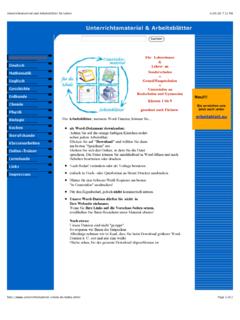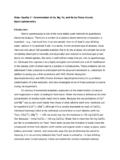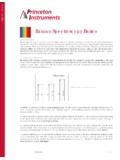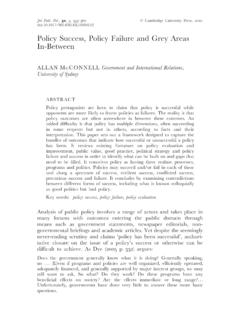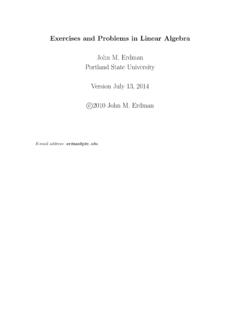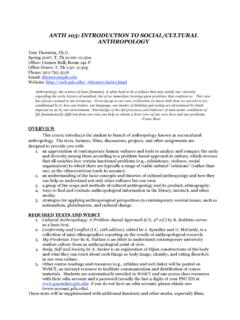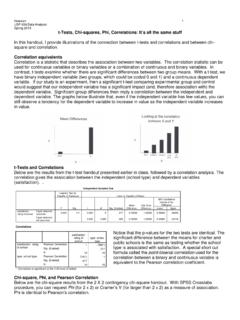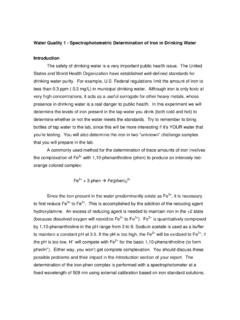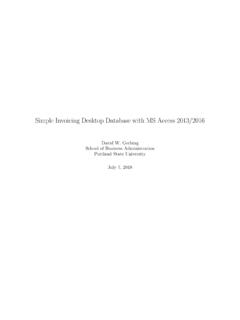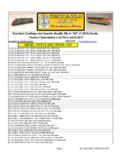Transcription of Distinguishing Between Random and Fixed
1 Newsom Psy 526/626 Multilevel Regression, Spring 2019 1 Distinguishing Between Random and Fixed : Variables, Effects, and Coefficients1 The terms Random and Fixed are used frequently in the multilevel modeling literature. The distinction is a difficult one to begin with and becomes more confusing because the terms are used to refer to different circumstances. Here are some summary comments that may help. Random and Fixed Variables A Fixed variable is one that is assumed to be measured without error. It is also assumed that the values of a Fixed variable in one study are the same as the values of the Fixed variable in another study.
2 Random variables are assumed to be values that are drawn from a larger population of values and thus will represent them. You can think of the values of Random variables as representing a Random sample of all possible values or instances of that variable. Thus, we expect to generalize the results obtained with a Random variable to all other possible instances of that value ( , a job candidate with a strong r sum ). Most of the time in ANOVA and regression analysis we assume the independent variables are Fixed . Random and Fixed Effects The terms Random and Fixed are used in the context of ANOVA and regression models and refer to a certain type of statistical model.
3 Almost always, researchers use Fixed effects regression or ANOVA and they are rarely faced with a situation involving Random effects analyses. A Fixed -effects ANOVA refers to assumptions about the independent variable and that error distribution for the variable. An experimental design is the easiest example for illustrating the principal. Usually, the researcher is interested in only generalizing the results to experimental values used in the study. For instance, a drug study might use 0 mg, 5 mg, and 10 mg of an experimental drug. This is a circumstance when a Fixed effects ANOVA would be appropriate.
4 In this example, the extrapolation is to other studies or treatments that might use the same values of the drug ( , 0 mg, 5 mg, and 10 mg). However, if the researcher wants to make inferences beyond the particular values of the independent variable used in the study, a Random effects model is used. A common example would be the use of public art works representing low, moderate, and high abstractness ( , statue of a war hero vs. a pivoting geometric design). The researcher would like to make inferences beyond just one art piece representing each category of abstractness, so the art pieces are conceptualized as pieces randomly drawn from a larger universe of possible pieces that are sampled from the domain for that level of abstractness.
5 For example, one could imagine using several instances of high abstract pieces that are randomly drawn from a larger population of high abstract pieces and are thought to be only a few of the possible particular instances of high abstract art. Thus, the inferences are made to a larger universe of art works with variations of abstractness within each category. Such a generalization is more of an inferential leap, and, consequently, the Random effects model is less powerful because we are taking into account some additional expected Random variation on the independent variable.
6 Random effects models are sometimes referred to as Model II or variance component models. Analyses using both Fixed and Random effects are called mixed models or "mixed effects models" which is one of the terms given to multilevel models. Fixed and Random Coefficients in Multilevel Regression (MLR) The Random vs. Fixed distinction for variables and effects is important in multilevel regression. In multilevel regression models, both level-1 and level-2 predictors are assumed to be Fixed . However, the intercepts and slopes in the level-1 equations may be allowed to vary randomly across groups and are therefore referred to as Random coefficients.
7 The variance of the intercepts is represented by 20 = var(U0j) and is nearly always estimated by default. The variance of the (first) predictor is represented by 1 My distinctions Between Random variables, effects, and coefficients was inspired by and relies heavily on Kreft & de Leeuw (1998). Newsom Psy 526/626 Multilevel Regression, Spring 2019 2 21 = var(U1j), and, depending on the circumstances, may not be allowed to vary for every The within-group variance, var(Rij) = 2, is also referred to as Random .
8 Because we may be interested in the variation of the coefficients across groups as a research question, one can think about 0j and 1j as akin to the Random variables I described above in the first section. Instead of attempting to generalize beyond the particular values of the independent variable, we are attempting to generalize beyond the particular groups in the study. For instance, we may have 100 companies, but we wish to generalize to a larger universe of companies when we examine the means (intercepts) or the X-Y relationship (slopes). Output from software packages will usually have sections labeled as Fixed effects and Random effects.
9 The Fixed effects are the coefficients (intercept, slope) as we usually think about the. The Random effects are the variances of the intercepts or slopes across groups. In the HLM program, variances for the intercepts and slopes are estimated by default (U0j and U1j, respectively). In SPSS Mixed and R (nlme or lme4), the user must specify which intercepts or slopes should be estimated. If any variance, intercept or slope, is not specified their values are set to zero. By setting variances to zero, we are testing a model in which we assume 0j and 1j do not vary randomly across groups.
10 Thus, the intercept or slope value is assumed to be constant or nonvarying across groups. For example, Fixed , nonvarying intercepts would imply the group average for the dependent variable is assumed to be equal in each group this implies no variance, so would be rarely assumed for intercepts. Note that although researchers sometimes refer to this constraint as fixing the intercepts or fixing the slopes, the term is somewhat loosely applied, because we are really assuming they are Fixed and nonvarying. References Kreft, I., & de Leeuw, J. (1998). Introducing multilevel modeling.
